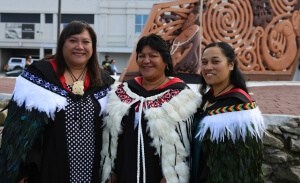
Maria Harakore Taylor, Marisa De Halvalanzia Neho and Mairia Sharlene Pullar graduating with a Bachelor of Arts (Māori).
Hundreds of EIT Students marched colourfully through Gladstone Road to a lively 2016 graduation ceremony at the War Memorial Theatre on April 22nd.
Total student numbers at EIT Tairāwhiti were a shade over 2400 last year, and this year students graduated in greater number, and from a wider range of programmes than ever, said EIT council chair, David Pearson.
“EIT Tairāwhiti awarded 557 qualifications last year to those completing programmes. That includes 481 certificates, 23 diplomas and 53 degrees – up from 36 the previous year.”
This 43 percent increase in degrees awarded comes as a result of seven degree programmes now on offer in Tairāwhiti, where EIT’s campus has the highest percentage of Māori students of any tertiary institution in the country. Around 72 percent of this year’s graduates identify as Māori.
Traditional whakataukī, or proverbs also featured. Valedictorian Isaac Hughes compared the efforts of graduating students to the tiny kōpara (bellbird) which flies to the top of the tānekaha tree to find the sweetest ripest berries. He also quoted Dr Seuss: “You’ll be on your way up, you’ll be seeing great sights, you will join the high fliers who soar to high heights. Oh the places you’ll go”.
EIT kaumātua Taina Ngarimu compared the encouragement of parents to the karere (I think this should be kārearea but might need to get checked by Taina) bird who sings loudly as it feeds its chicks, then falls silent when it is time for them to leave the nest for the wider world.
There was a great deal to look back on with pride in 2015, said EIT chief executive Chris Collins.
“We received the top possible ranking for educational performance by the New Zealand Qualifications Authority. Last year we had our fifth masters degree approved as an institution – Master of Professional Creative Practice – here at Toihoukura in Tairāwhiti and also at the ideaschool in Taradale. It sits alongside the other four masters degrees. We also had our third honours degree approved last year Bachelor of Social Work, Honours, and Bachelor of Professional Creative Practice which sits alongside our Bachelor of Arts (Māori) Honours, all of which can be studied here in Tairāwhiti. We also established a new school of primary industries last year, led from here across the EIT regions,” said Mr Collins.
There was also the celebration of 40 years as an institution, the first emeritus professor, Professor Dr Roger Maaka from Te Ūranga Waka, and three staff members who received Queens Birthday honours.
“Ministry of Foreign Affairs and Trade purchased and commissioned artworks from Toihoukura to hang in embassies around the world.”
There was much to be proud of in the room, and it is important to maintain momentum for the sake of the region, said Gisborne Herald editor Jeremy Muir, who was the guest speaker.
“My view is that this region is on the verge of making real, step changes in the prosperity and well-being of its people – but that we could very well scotch the opportunities now emerging by not being details-focused or well co-ordinated. We are too small, our financial resources are too limited and the future of our children is too important for us to allow this to happen.
“Take this theatre as an example. The community has done a wonderful job redeveloping it, at a cost of $10 million. It was officially reopened a year ago . . . but the marketing of it as a venue for shows and events has yet to really begin. It lies idle for too much of the time, and the people of the Tairāwhiti are so far missing out on a fair portion of the promise that came with its reopening.”
Be brave and make a difference, said Mr Collins.
“We hope that our graduates will make a difference in their whānau, their communities and their worlds where they go to live and work. Don’t be afraid to go out and bring some change, give things a crack.”
